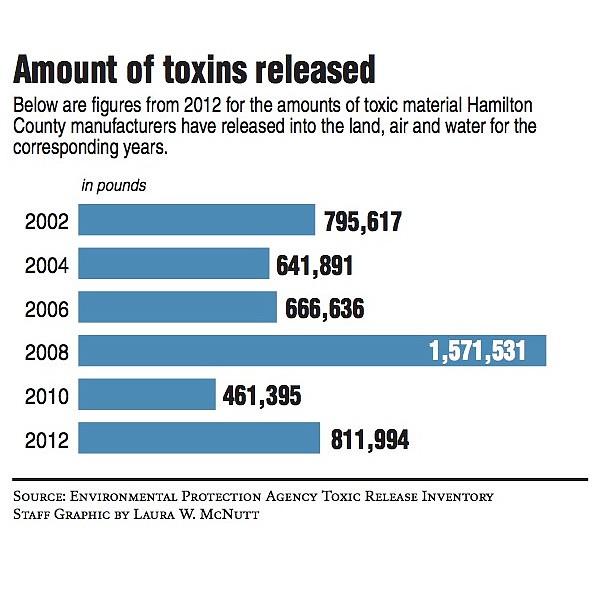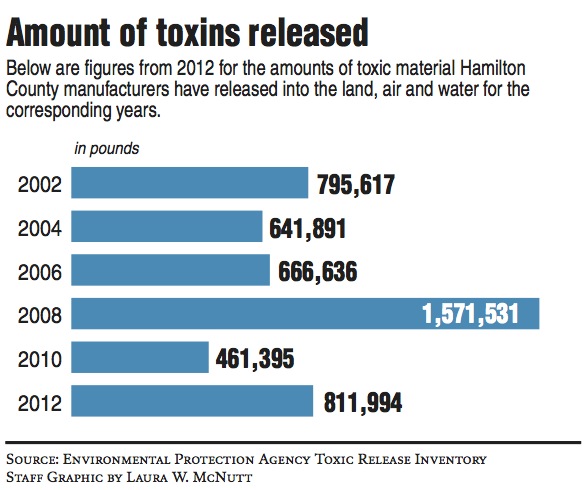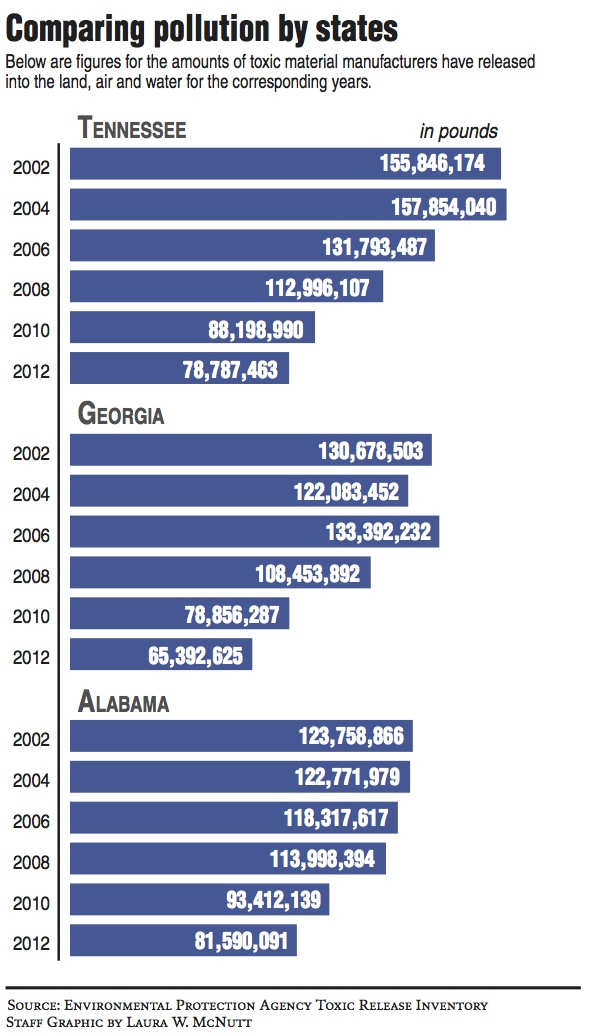WHAT IS THE TRI?The Toxic Release Inventory was started in 1986 in response to a massive manufacturing chemical release at a Union Carbide chemical plant that had killed thousands in Bhopal, India, two years before.The program requires manufacturers that release certain amounts of carcinogens or other chemicals that can harm human health or the environment to report what is released into the land, water or air.
Hamilton County has come a long way in cleaning up its dirty manufacturing past, but federal environmental reports show it still needs to keep close tabs on its manufacturing future.
Based on 10 years of data, the county lags behind the nation, region and state in reducing its toxic emissions footprint from manufacturing -- even though the biggest local contributor is hailed as one of the cleanest automobile plants in the world.
According to the Environmental Protection Agency's annual Toxic Release Inventory, since 2002 the United States has reduced toxic emission releases by 1.1 billion pounds -- from 4.7 billion pounds in 2002 to 3.6 billion in 2012. The reduction is near the weight of 13,750 fully loaded 18-wheelers.
Tennessee, the 12th-biggest polluter out of the 56 states and territories the EPA covers, has reduced its toxic output by 49 percent -- from 156 million pounds in 2002 to 79 million pounds in 2012.
But Hamilton County produced around the same amount of toxic emissions in 2012 as it did a decade before. And the leading emitter was the nation's first LEED platinum automaker -- Volkswagen Group of America Chattanooga. Ten years ago, first place was held by the now-shuttered U.S. Pipe and Foundry.
According to the inventory, Volkswagen released 431,570 pounds of chemicals, accounting for 51 percent of all the air releases in the county. The next highest contributors were South Atlantic Galvanizing, which released 67,700 pounds of material, and Alstom Power, which generated 58,390 pounds.
Volkswagen officials say the TRI rankings are misleading, and the automaker is releasing much less than its federal and state permits allow.
Ron Drumeller, an environmental specialist for VW, said the Chattanooga plant is operating at 179 tons, or 358,000 pounds, of average annual emissions of volatile organic compounds -- that's 20 percent of the 932 tons it is permitted to release without posing environmental or health risks, he said.
In all, manufacturers in Hamilton County put 811,994 pounds of toxic material into the environment in 2012.
That number is large. But it doesn't hold a candle to the 5.3 million pounds of toxins released by Hamilton County manufacturers in 1992, or the 10 million pounds released in 1988.
Great strides
Most of Hamilton County's great strides happened from 1970 to 1990, according to J. Wayne Cropp, an environmental attorney who led the county's Air Pollution Control Bureau from 1979 to 1990.
"The fact that the numbers now are only about 10 percent from the emissions [released] in 1990, we should be very proud of that," Cropp said.
Large reductions were spurred by amendments to the Clean Air Act in 1990 that placed much stronger restrictions on manufacturers, Cropp said.
Looking at short periods of TRI data doesn't show the broad picture, he said. That's partly because manufacturing emissions tend to track with the economy, and partly because the list the EPA uses for the annual inventory changes.
"You cannot do a year-by-year comparison unless you can take out the outliers. The list [of volatile chemicals] is not static; it's a moving target," Cropp said.
The key reason Hamilton County's numbers don't match the large reductions in the state or region has to do with how we get our power, he said.
"In the last decade, one of the reasons you are seeing national and statewide reductions that are so positive is we are seeing major reductions in power production from coal-fired power plants," Cropp said. "But we don't have a coal-fired power plant in Hamilton County, we have a nuclear power plant. It doesn't show up in Hamilton County, because we don't have that kind of emission source."
Current Air Pollution Control Bureau Director Bob Colby said great improvements have been made to clear the air in Hamilton County since the 1990s, too, although they are less dramatic because much of the heavy lifting has been done.
There will be toxic emissions as long as there is manufacturing, Colby said, but he noted that new industries are held to more stringent standards than in the past.
However, there are too many variables to say whether Hamilton County's manufacturing emissions have "bottomed out," he said.
The TRI has played a big role in cleaning up the air because manufacturers started thinking differently about how they made their products, Colby said. Some of the commonly used chemicals were restricted, and communities started to learn about chemicals pouring out of industrial smokestacks.
"It's not only that, but it's how they approach their way of doing business. Decades ago, there wasn't a whole lot of thought given to conserving. People said, 'We've always made this product this way, so that's how we make it,'" he said.
Manufacturers realized that high emissions meant low efficiency and bad publicity.
"I think the TRI program has been the most successful program EPA has ever launched," Colby said. "Nobody really wanted to be the worst in their community."
Nationwide, EPA spokeswoman Julia Ortiz said, it's difficult to pinpoint exact reasons for large reductions from 2002 to 2012, but changes to the way metal miners report might have had an impact.
She said there was a large reduction in Tennessee starting in 2005 because the Volunteer State was affected by the Clean Air Interstate Rule that further regulated particulate matter and ozone levels.
Top of the list
Volkswagen officials say, for starters, that nearly half of its TRI-reported air emissions labeled as "certain glycol ethers" have been deemed nonhazardous by other branches of the EPA.
Glycol ethers are a group of hundreds of similarly structured chemical compounds. VW released 212,406 pounds of glycol ethers in 2012. But 203,406 pounds of that was ethylene glycol monobutal ether -- or EGBE -- a chemical EPA ruled nonhazardous in 2004. The other five glycol ethers VW releases are equally harmless, Drumeller said.
At VW, almost all the air emissions come from the plant's paint shop. EGBE is used in the base coating process, so there are emissions during the spraying. Other emissions are released when the painted cars are "baking" in the drying oven, Drumeller said. Virtually all of those fumes are funneled into oxidizers, which incinerate the chemicals and disperse them through smoke stacks.
Sarah Sajedi, a consultant with ERA Environmental, who supplies environmental accounting software to VW, said the company has to report EGBE, even though the EPA considers it benign.
"It was listed as a hazardous air pollutant, but studies have been done to show that it is not hazardous for humans. It is still a glycol ether, so when you report this chemical you are obliged to include it," Sajedi said. "They maybe should remove it from toxic release inventory, but they haven't."
Still, three other chemicals -- xylene, n-butyl alcohol and n-methyl-2-pyrrolidone -- make up an additional 183,846 pounds of VW's emissions. They are hazardous when injested or directly inhaled in large quantities, according to EPA reports. But Volkswagen says they are dispersed to nonhazardous levels when released.
Sajedi, who has been an environmental consultant for more than 20 years, said the TRI is a good report, but the big numbers can give people the wrong impression.
First, she said, when stretched out over two 10-hour shifts a day for 12 months, the 183,846 pounds translates to about 25 pounds of chemical an hour, she said. Second, she said, the VOCs are lighter than air and are released from 102-foot-tall oxidation stacks. The chemicals float up into the atmosphere and disperse into the air at levels EPA permits deem safe, she said.
"Human health effects are literally nonexistent, because if you look at the dispersion modeling they do for health effects, these are air emissions that do not necessarily translate to human exposure," Sajedi said. "The Toxic Release Inventory is wonderful. The people's right to know is important and very useful. But if you read it and just look at the numbers annually, it's misleading."
Colby said Volkswagen is at the top, but it still runs about as cleanly as it can.
"Just because Volkswagen is at the top of the list doesn't mean they are going to be creating an unacceptable health risk to the community, because they are absolutely not doing that."
South Atlantic Galvanizing, mainly produces zinc compounds and lead, most of which are taken to companies in Texas and Ohio, according to the TRI. The bulk of Alstom Power's releases, 58,336 pounds, are glycol ethers released in the air.
Contact staff writer Louie Brogdon at lbrogdon@timesfreepress.com or at 423-757-6481.


